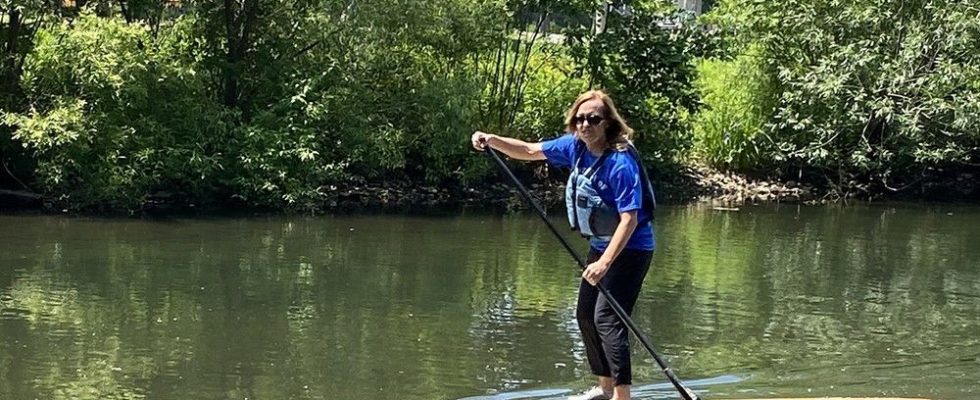Simcoe Composite School project took three months to complete

A standup paddleboard built by Simcoe Composite School students went on its official maiden voyage last week.
SCS principal Jennifer Ippolito flawlessly paddled the craft, made with thin wood strips consisting of basswood, cherry and walnut, a core of plywood, and an exterior clear-coat of fibreglass, in front the student body near the school.
“It’s a modern paddleboard,” said Jeremy Theobald, SCS construction technology teacher, noting the design was purchased from a company in Texas.
Inside, the paddleboard itself is completely hollow. The students used a bandsaw to re-saw all the basswood, cherry and walnut down to a thickness of 3/8” and one-inch wide strips that were glued to a ¼” plywood ‘skeleton’ – the backbone and ribs – then sanded and shaped.
“Basswood is very, very light, so that’s the main body of the paddleboard. And we used cherry and walnut just for aesthetics.”
Theobald’s senior class of 13 students started on the paddleboard project after March break and completed the 11’4”x2’8” craft “just in time” for its official June 21 launch.
“We had a ‘secret’ test run on Monday (June 19) and it was just amazing,” said Theobald. “It performed so good on that test run and it looked so good, and our principal (Jennifer Ippolito) really paddled it well, so we were confident going into Wednesday when she paddled it in front of the school.
“I gave her many opportunities to get out of the deal and she didn’t take it,” Theobald laughed.
Theobald said the idea for the project developed over the entire year.
“I had a great class, and I liked the Indigenous kind of education that could go into it. Every culture creates and uses technology. We all make things, so this was a way of connecting a popular, modern standup paddleboard with Indigenous cultures who have been making canoes, and that kind of transportation, for a long time. I thought it would be interesting to make that kind of connection.”
There was also an art component: A Grade 9 SCS student won a contest creating an Indigenous design that incorporated the resources and stewardship of water.
Along with building the paddleboard, there was work to be completed in the background, said Theobald, which included building a flat, straight table, and a wood steaming/bending chamber.
“They learned a lot of things with this project. Everyone had their hands on (building) it. We basically worked on it every day for four months, with some other projects mixed in. Some steps (gluing strips) in the process were very long.”

The paddleboard’s future is unknown, but it will likely be displayed at the school for some time.
“We definitely want to admire it for quite a while because it’s pretty beautiful. It’s really quite stunning.”
Theobald noted the standup paddleboard was an inter-department project with assistance from science teachers Chris Hagen and Brian Snow, who supplied fiberglass and boatbuilding experience.
“I had never built one personally before, so this challenge was new and pretty intimidating at the outset,” said Theobald.
“It was a phenomenal project and we’re really pleased and proud of the students, and really thankful for our admin and the other partners here that helped us with this project.”

Comments
Postmedia is committed to maintaining a lively but civil forum for discussion and encourages all readers to share their views on our articles. Comments may take up to an hour for moderation before appearing on the site. We ask you to keep your comments relevant and respectful. We have enabled email notifications—you will now receive an email if you receive a reply to your comment, there is an update to a comment thread you follow or if a user you follow comments. Visit our Community Guidelines for more information and details on how to adjust your email settings.
Join the Conversation